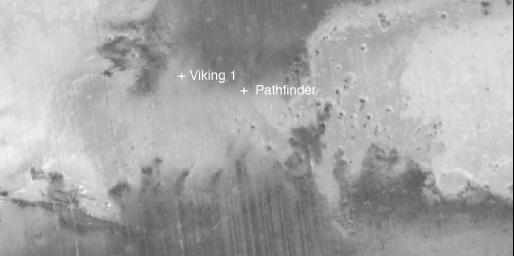
|
New Views of Mars from the Thermal Emission Spectrometer Instrument
- Click the image above for a larger view
- Full-Res JPEG (874 x 436) (34.3 kB)
- Full-Res TIFF (874 x 436) (254.5 kB)
Caption:
During the first 1500 orbits (March through August, 1999) of the Mars Global Surveyor (MGS) mapping mission the Thermal Emission Spectrometer (TES) instrument has been measuring the surface brightness (albedo) of Mars. In this figure of all of the TES data acquired during that period have been combined to produce a detailed image of the Martian surface. The region shown includes the equatorial region of Mars where both the Pathfinder and Viking 1 spacecraft landed. The dark regions are areas swept free of dust by the Martian winds, whereas the brighter regions are areas of dust accumulation.
These bright and dark markings are known to change over time as the Martian winds move dust and sand across the surface. The TES measurements are providing a means of tracking these changes in very precise manner. Note that the Pathfinder landing site is located near the boundary between bright and dark regions and that the landing site is located in a region of modest dust accumulation.
Background Info:
The TES instrument was built by Raytheon Santa Barbara Remote Sensing and is operated at Arizona State University as part of NASA's Mars Global Surveyor mission. The MGS mission is managed by the Jet Propulsion Laboratory in Pasadena, CA and operated in conjunction with Lockheed Martin Astronautics in Denver, CO.
Cataloging Keywords:
| Name | Value | Additional Values |
|---|---|---|
| Target | Mars | |
| System | ||
| Target Type | Planet | |
| Mission | Mars Global Surveyor (MGS) | Viking |
| Instrument Host | Mars Global Surveyor | |
| Host Type | Orbiter | |
| Instrument | Thermal Emission Spectrometer (TES) | |
| Detector | ||
| Extra Keywords | Dust, Grayscale, Thermal | |
| Acquisition Date | ||
| Release Date | 1999-08-31 | |
| Date in Caption | ||
| Image Credit | NASA/JPL/ASU | |
| Source | photojournal.jpl.nasa.gov/catalog/PIA02320 | |
| Identifier | PIA02320 | |
